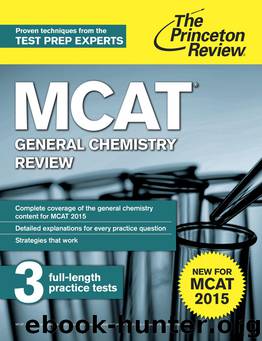MCAT General Chemistry Review by Princeton Review

Author:Princeton Review [Review, The Princeton]
Language: eng
Format: epub
ISBN: 978-1-101-88241-2
Publisher: Random House Children's Books
Published: 2015-03-16T16:00:00+00:00
= 16.6 atm – 0.9 atm = 15.7 atm
This represents a 4% decrease in pressure from that predicted by the ideal gas law.
To underscore the concept that gases behave more ideally at higher temperatures, if we increase the temperature of the system for any gas, the first term in the van der Waals equation approaches the pressure of the ideal gas while the second term remains unchanged. For example, if the temperature of our systems above is increased by 100 K (to 600 K), two moles of an ideal gas would exert 19.7 atm of pressure, while the van der Waals equation predicts pressures of 19.7 atm and 19.1 atm for oxygen and water, respectively. Therefore, we can see that at increased temperature the real gas (H2O) behaves more ideally since it now deviates by only 3% from the pressure predicted by the ideal gas law.
So conceptually, why do higher pressures and lower temperatures cause larger deviations from ideal behavior? As pressure increases, gas particles become closer to one another. This accentuates the effects of attractive intermolecular forces, causing a decrease in observed pressure (Preal < Pideal). Similarly, at low temperatures intermolecular forces become more important, and when taken to an extreme, cause condensation to occur. Liquids aren’t very ideal gases. In addition, when gas particles are packed closer to one another at high pressures, particle volume of the gas itself begins to limit the free space in which the gas particles can move (Vreal < Videal). However under extremely high pressure, these particles can begin to repel one another leading to an increase in volume.
To summarize, those gases that behave most ideally have the weakest intermolecular forces and the smallest molecular weights (and volumes). Furthermore, by maintaining conditions of high temperature and low pressure, the potential interactions between particles are minimized and particle volume remains insignificant compared to the container size, helping to favor more ideal behavior for all gases.
Example 8-8: Of the following, which gas would likely deviate the most from ideal behavior at high pressure and low temperature?
A) He(g)
B) H2(g)
C) O2(g)
D) H2O(g)
Download
This site does not store any files on its server. We only index and link to content provided by other sites. Please contact the content providers to delete copyright contents if any and email us, we'll remove relevant links or contents immediately.
Cracking the GRE Premium Edition with 6 Practice Tests, 2015 (Graduate School Test Preparation) by Princeton Review(4250)
Kaplan MCAT Organic Chemistry Review: Created for MCAT 2015 (Kaplan Test Prep) by Kaplan(3972)
Kaplan MCAT Behavioral Sciences Review: Created for MCAT 2015 (Kaplan Test Prep) by Kaplan(2960)
MCAT Psychology and Sociology Review: New for MCAT 2015 by Princeton Review(2837)
The Official Guide for GMAT Review 2015 with Online Question Bank and Exclusive Video by Graduate Management Admission Council (GMAC)(2782)
Programming in C (4th Edition) (Developer's Library) by Stephen G. Kochan(2132)
Cracking the LSAT, 2012 Edition by Princeton Review(1920)
GRE Premier 2017 with 6 Practice Tests by Kaplan(1839)
GMAT Official Guide 2018 Verbal Review by GMAC (Graduate Management Admission Council)(1833)
The PowerScore LSAT Logical Reasoning Bible by David M. Killoran(1833)
MCAT Physics and Math Review 2019-2020 by Kaplan Test Prep(1787)
Peterson's Master the GRE 2014 by Moran Margaret(1730)
GRE-Verbal Behind The Scenes 2014: Discover BTS of ETS (GRE Test Prep) by Bashir Hosseini Jafari(1685)
MCAT 528 Advanced Prep 2018-2019 by Kaplan Test Prep(1675)
MCAT Physics and Math Review by Princeton Review(1660)
Text Completion & Sentence Equivalence GRE Strategy Guide by Manhattan Prep(1560)
Math Workout for the GRE by Princeton Review(1558)
Kaplan MCAT Critical Analysis and Reasoning Skills Review: Created for MCAT 2015 (Kaplan Test Prep) by Kaplan(1538)
GMAT For Dummies by Lisa Zimmer Hatch & Scott A. Hatch(1507)
